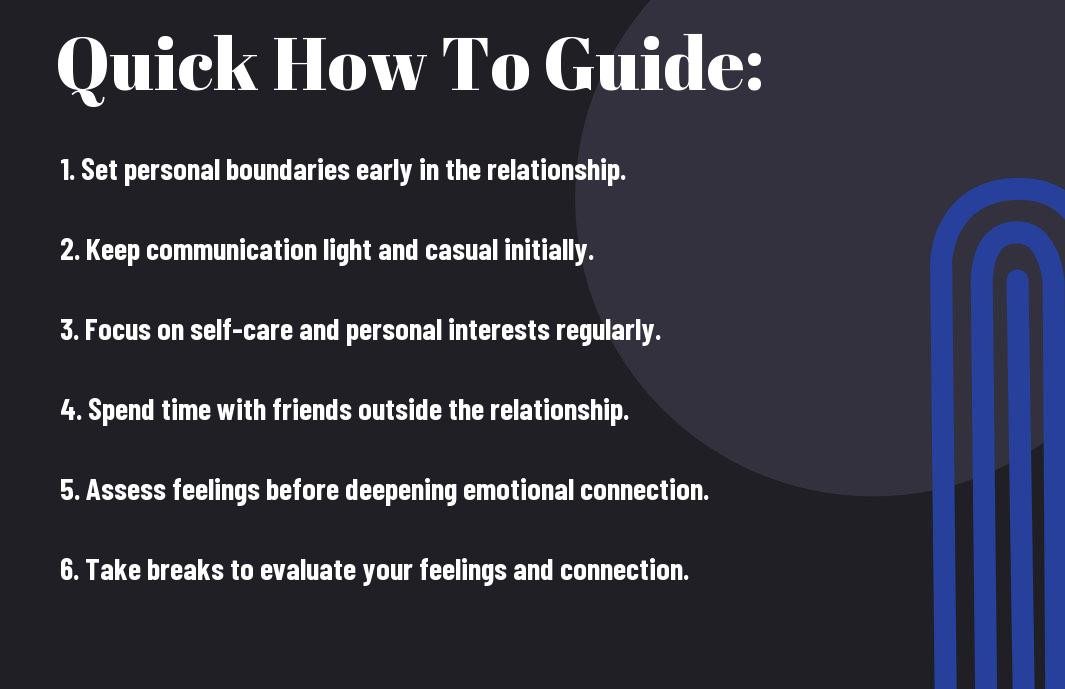Many people struggle with forming deep emotional connections and often find themselves becoming too attached too quickly. This can lead to feelings of anxiety and disappointment when relationships don’t develop as expected. In this guide, you’ll discover practical strategies to help you take your time and maintain healthy emotional boundaries while fostering genuine connections. By applying these tips, you can learn to enjoy the excitement of new relationships without overwhelming your heart too soon.
Understanding Attachment
Before delving into relationships, it’s vital to grasp the concept of attachment. Attachment is an emotional bond that ties you to another person, often shaping how you relate and connect. Understanding it can help you avoid rushing into deep emotional connections too soon, allowing you to maintain healthy boundaries while nurturing relationships at a pace that feels right for you.
The Psychology of Attachment
Little do people realize that their attachment styles stem from early experiences. These styles—secure, anxious, and avoidant—affect how you form relationships and respond to intimacy. By gaining insight into your attachment style, you can make more conscious choices in your interactions, fostering healthier connections without becoming overly attached too quickly.
Factors Influencing Emotional Attachment
Emotional attachment can vary significantly from person to person, and several factors play a role in shaping it. Importantly, the following elements can influence your emotions:
- The depth of shared experiences
- Your personal history with relationships
- The level of vulnerability you engage in
- Your communication patterns
Perceiving these influences can help you better navigate your emotional landscape and maintain balance in your relationships.
To cultivate a balanced approach to emotional attachment, consider how these factors interact in your life. Regular self-reflection can provide insight into what may trigger your attachment feelings:
- Your tendency to idealize partners
- The frequency and quality of interactions
- Shared values and interests
- External pressures, such as societal expectations
Perceiving these factors in your own life can empower you to form connections thoughtfully and at a pace that feels comfortable for you.

Recognizing Signs of Over-Attachment
If you find yourself questioning your sense of self-worth based on your relationship with someone, it may be time to take a step back. You can learn more about 13 important ways to stop getting emotionally attached … to prevent emotional dependencies from forming too quickly.
Common Symptoms
Signs of over-attachment include constantly seeking reassurance from your partner, feeling anxious when not in contact, or prioritizing their needs over your own. These patterns can lead to an unhealthy emotional dynamic, making it vital to acknowledge them early.
Red Flags to Watch For
You may notice that you frequently sacrifice your personal interests or friends to maintain closeness with someone. Additionally, feeling overly possessive or jealous can be indicators of excessive attachment.
It’s necessary to evaluate how your feelings influence your actions and decisions. If you start isolating yourself or neglecting responsibilities for the sake of another person, these might be significant red flags. Engaging in self-reflection and seeking balance can help mitigate these feelings and foster healthier relationships.
Setting Healthy Boundaries
Your journey to avoid getting too attached too quickly begins with establishing and respecting healthy boundaries. Boundaries help define the limits of what you are comfortable with, protecting your emotional wellbeing and fostering mutual respect in relationships. By being clear about your expectations, you create a balanced dynamic that allows for genuine connection without the risk of overwhelming attachment.
Importance of Personal Space
Healthy personal space is imperative for maintaining your individuality and emotional stability. Establishing this space grants you the freedom to recharge and pursue your interests independently, reducing the likelihood of losing yourself in a relationship. By honoring your personal space, you encourage a more balanced and less dependent connection with others.
Communicating Your Needs
Communicating your needs effectively lays the foundation for a healthy relationship dynamic. When you express what you require—whether it be emotional support, alone time, or specific activities—you create an environment where both you and your partner can thrive. Clear communication allows for understanding and compromise, ensuring both parties feel valued and respected.
Understanding your own needs and openly sharing them with others is key to preventing unhealthy attachment. It involves recognizing what makes you comfortable, what you value in relationships, and how much space you require. When you articulate these needs, you lay the groundwork for both personal and relational growth, positioning you to cultivate healthier, more fulfilling connections.
Developing Emotional Independence
Many people find it easy to lose themselves in relationships, but developing emotional independence is key to maintaining a healthy balance. Fostering self-reliance allows you to cultivate your own interests and goals, making you less dependent on your partner for validation and happiness. By nurturing this independence, you create a strong foundation for your relationships, ensuring that they enhance your life rather than define it.
Fostering Self-Awareness
An effective way to build emotional independence is through self-awareness. Pay attention to your feelings, triggers, and reactions in different situations. Understanding your emotions helps you recognize unhealthy patterns in attachment and empowers you to respond thoughtfully rather than impulsively. This insight enables you to cultivate a deeper connection with yourself, fostering confidence and resilience in your relationships.
Building Your Own Support System
Some of the strongest forms of emotional independence come from cultivating a solid support system outside of your romantic relationships. Surround yourself with friends, family, and mentors who uplift you and provide perspective. Establishing connections with those who share similar interests and values helps create a network of support that can bolster your emotional well-being, making it easier to establish healthy boundaries in your primary relationship.
The relationships you build outside of your romantic interests are imperative to fostering emotional independence. By engaging in activities that interest you, such as joining clubs, attending workshops, or volunteering, you widen your circle and enrich your life with diverse interactions. These connections not only offer joy and support but also help reinforce the idea that your self-worth doesn’t solely depend on your relationship. As you nurture these bonds, you will find that you can rely on your support system when challenges arise, allowing you to approach your romantic relationships with a healthier perspective.

Taking Things Slow
Unlike the fast-paced relationships often portrayed in media, taking your time allows for a deeper connection to develop naturally. A slower pace gives both you and your partner the opportunity to truly learn about each other’s values, interests, and compatibility. By resisting the urge to rush into deeper emotional territory, you create a solid foundation built on trust and understanding.
The Benefits of Patience
Taking your time in a relationship leads to a stronger bond, as it fosters meaningful conversations and experiences together. When you allow feelings to evolve gradually, you’re more likely to avoid rushing into commitments that might not be right for you, leading to a healthier and more sustainable connection.
Strategies for a Gradual Relationship Pace
You can maintain a steady pace by setting boundaries and focusing on incremental growth in your relationship. It’s important to prioritize quality interactions over quantity, allowing time for both you and your partner to reflect on your feelings.
This gradual approach can involve regular check-ins about each other’s comfort levels, planned date nights that focus on shared activities rather than intense intimacy, and taking breaks when needed. By balancing openness with a mindful pace, you can cultivate a sense of safety and stability, which is necessary for a lasting connection.
Maintaining a Balanced Perspective
To avoid becoming overly attached too quickly, it’s necessary to maintain a balanced perspective. A healthy outlook on relationships allows you to enjoy the connection without losing your sense of self or ignoring potential red flags. Focus on getting to know the other person and yourself while avoiding the urge to idealize them or the relationship. This balance fosters healthy growth and emotional safety, enabling you to engage deeply without the fear of losing yourself in the process.
Embracing Realistic Expectations
Realistic expectations are fundamental to cultivating a stable relationship. Set aside notions of perfection and accept that every connection has its ups and downs. Understand that both you and your partner will have flaws and that challenges are part of growth. By expecting the relationship to evolve over time, you create room for genuine intimacy while safeguarding yourself against sudden emotional turmoil.
Understanding Love and Attachment
While love can be exhilarating, it’s necessary to differentiate it from unhealthy attachment. Recognizing the difference allows you to engage in a fulfilling relationship without losing your independence. Strong attachment can often blind you to red flags and lead to dependency. By understanding what genuine love looks like, you can ensure that your feelings are based on mutual respect and shared values, fostering a healthier emotional landscape.
The way you perceive love and attachment plays a pivotal role in how you form relationships. Love thrives on mutual respect, admiration, and individuality, while attachment can sometimes create a sense of dependency. It’s important to identify patterns in your past relationships that may have fostered unhealthy attachments, as this awareness enables you to cultivate healthier dynamics. Strive to nurture connections that encourage emotional balance and growth, ensuring that your affection doesn’t overshadow your personal goals and needs.
To wrap up
The key to avoiding getting too attached too quickly lies in maintaining a balanced approach to relationships. Focus on fostering your independence, cultivating hobbies, and nurturing friendships outside of your romantic interests. Take the time to genuinely understand the person you’re engaging with; observe their behavior and values without rushing to invest emotionally. By pacing your emotional involvement and setting healthy boundaries, you can develop a more profound connection without the overwhelming desire for quick attachment. This thoughtful approach will enhance your emotional well-being and create more fulfilling relationships.










